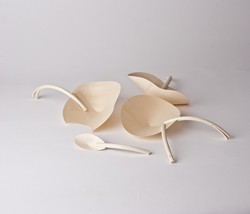Adriena Pekárová
The 6th Rings in water competition ended by an exhibition in the ÚĽUV Gallery at Obchodná Street in Bratislava in December 2010. It is an opportunity for young designers, artist, and students to learn more about folk art and crafts as rich source of inspiration for contemporary art work. Prejudices of young generation against traditional culture have been eliminated. Dozens of secondary schools and undergraduate students and few from the middle generation artists registered for and displayed their items at the exhibition. This competition which takes place every second year has won recognition as the presentation of work of young generation. Two teachers, namely head of design department at the University of Technology in Košice and former head of the wood design and shaping at the ŠÚV J. Vydra in Bratislava Marko Huba comment on this year´s competition.
Tibor Uhrín: This year of the Rings in water competition is not very different from the previous five years. The difference is that, amount of competition designs with fresh opinion on traditions has increased. Young people do not live with the burden of tradition and they interpret it easily, with fun or irony. Amount and variety of such approaches is perhaps surprising. It is because innovative ideas that work with traditional crafts and traditional materials have almost exhausted with time. However, new space for overlapping design and traditional crafts has emerged. Well, it is a natural and appropriate process. It is perhaps the highest time to change the concept and conditions of the competition which now gives space for such “funny” designs. However, the design category should remain unchanged to respect traditional crafts and materials. This would help to keep the original purpose of the competition, which was to have the range of products that would be interesting for a contemporary buyer, unchanged. …….. Students are the most numerous group of registered applicants and they are certainly not expected to be strongly involved in the traditional crafts. More research work and experience are necessary for innovating traditional crafts and to include them into design. It is the reason why similar concepts emphasizing, for example a visual experience, appear. Such things liven up the competition and it is good to give them more space. …. It is the only way how to mix traditional designs and pop-culture, traditional materials and technologies and contemporary ones. Some of such things may help to liven the exhibition and then gone with the wind. But, other things can make crafts, design and traditional culture more popular. It may be the way how to avoid what happens around the world where craft workshops massively extinguish.
Marko Huba: Massive registration of schools has introduced more freedom to crafts, tradition and unconventional materials to the competition. A student usually cannot compete with workmanship of an old master. However, they have courage and freedom to do experiments which may result in disaster or surprise. One of the most important achievements is that young generation, mostly students and graduate of design schools have discovered folk culture for themselves. It is very bad that the capital of the country with very rich and diverse ethnographic and craft heritage does not have a museum of crafts, folk art and design. It is no wonder that some displays are far enough from the values we want to revive. It is perhaps time to initiate a discussion among authors, teachers, competition judges and experts from and outside the ÚĽUV that would help to raise questions and define answers on the purpose of traditions in our global, consumerist and busy world. …….. Ten years ago, I raised a question in my article about tradition published in the RUD magazine if looking back my help to correct our way forward? Well, I believe as I believed ten years ago – yes, it is possible.
